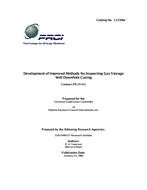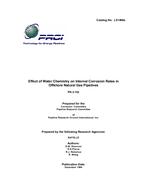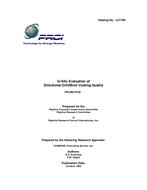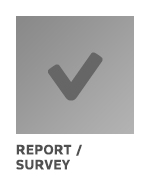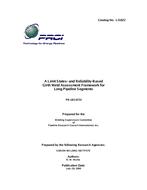Provide PDF Format
PRCI PR-15-411
- Development of Improved Methods to Inspect Storage Well Downhole
- Report / Survey by Pipeline Research Council International, 01/31/1986
- Publisher: PRCI
$98.00$195.00
L51506e
Southwest Research Institute
Need: Casing corrosion in storage wells is a matter of considerable concern to the gas storage industry. Such wells are typically flowed through the casing rather than through production tubing, to facilitate high flow capacities. When failures occur, gas leakage to surrounding formations, freshwater zones and to the surface can pose a sizable economic loss as well as a serious safety hazard. For these reasons, monitoring corrosion in down-hole casing in gas storage fields has become a major concern of many storage field operators, and the in situ detection and assessment of corrosion damage by means of logging instruments is a significant part of this effort.
Result: The study reported in this document has sought to investigate in detail the objectives, methods and results of currently available commercial logging devices as a first step in determining whether down-hole corrosion damage can be more accurately characterized by improved logging methods. Of the several methods potentially capable of meeting the through-wall measurement requirement, only two form the basis for current commercial corrosion logs: the flux leakage, or magnetic perturbation technique, and the remote field eddy current approach. In seeking to provide reasonably short term performance improvements to the industry, it was decided in this project to pursue refinements of magnetic perturbation logs for two reasons: first, the shortcomings evidenced by present logs of this type appear to be amenable to relatively simple improvement, and second, the remote field eddy current approach, while useful as an adjunct to damage assessment, offers little promise of sizing individual corrosion flaws.
Benefit: The experimental and theoretical studies performed during this project demonstrate that sufficient information is available at the down-hole sensors, if the complete sensor signals could be brought to the surface for analysis. The implementation of this step probably represents the most significant single improvement possible to increase the effectiveness of the flux leakage logging method. The application of modern digital electronics to the down-hole instrumentation together with relatively simple computer handling of the data at the surface can accomplish this end. Such techniques were impractical when present corrosion logging systems were developed, but are now relatively straightforward. A plan for demonstrating the capabilities of such a system are outlined and recommended in the body of the report.
Southwest Research Institute
Need: Casing corrosion in storage wells is a matter of considerable concern to the gas storage industry. Such wells are typically flowed through the casing rather than through production tubing, to facilitate high flow capacities. When failures occur, gas leakage to surrounding formations, freshwater zones and to the surface can pose a sizable economic loss as well as a serious safety hazard. For these reasons, monitoring corrosion in down-hole casing in gas storage fields has become a major concern of many storage field operators, and the in situ detection and assessment of corrosion damage by means of logging instruments is a significant part of this effort.
Result: The study reported in this document has sought to investigate in detail the objectives, methods and results of currently available commercial logging devices as a first step in determining whether down-hole corrosion damage can be more accurately characterized by improved logging methods. Of the several methods potentially capable of meeting the through-wall measurement requirement, only two form the basis for current commercial corrosion logs: the flux leakage, or magnetic perturbation technique, and the remote field eddy current approach. In seeking to provide reasonably short term performance improvements to the industry, it was decided in this project to pursue refinements of magnetic perturbation logs for two reasons: first, the shortcomings evidenced by present logs of this type appear to be amenable to relatively simple improvement, and second, the remote field eddy current approach, while useful as an adjunct to damage assessment, offers little promise of sizing individual corrosion flaws.
Benefit: The experimental and theoretical studies performed during this project demonstrate that sufficient information is available at the down-hole sensors, if the complete sensor signals could be brought to the surface for analysis. The implementation of this step probably represents the most significant single improvement possible to increase the effectiveness of the flux leakage logging method. The application of modern digital electronics to the down-hole instrumentation together with relatively simple computer handling of the data at the surface can accomplish this end. Such techniques were impractical when present corrosion logging systems were developed, but are now relatively straightforward. A plan for demonstrating the capabilities of such a system are outlined and recommended in the body of the report.
Related Products
PRCI PR-3-152
Effects of Water Chemistry on Internal Corrosion Rates in Offshore Natural Gas Pipelines..
$148.00 $295.00
PRCI PR-185-9733
Limit States and Reliability-Based Girth Weld Assessment Framework for Long Pipeline Segments..
$298.00 $595.00

